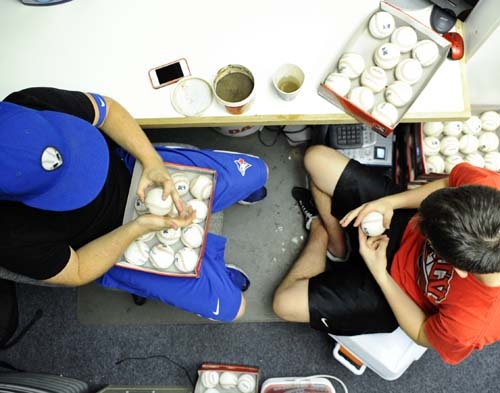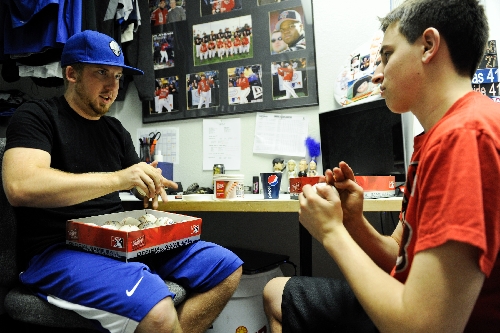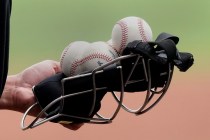Future mucky, usually short for these baseballs
The life of a professional baseball isn't always glamorous.
While a bevy of historic balls enjoy long, lush lives at the Baseball Hall of Fame in Cooperstown, N.Y., most have a short shelf life.
Born in Costa Rica, where all of Rawlings' official pro baseballs are made, new balls arrive at American ballparks like Las Vegas' Cashman Field in pristine condition - shiny, pearly white and individually wrapped.
But before they're deemed ready for play in the national pastime named for them, their futures are muddied. Literally.
Since 1939, the use of "Lena Blackburne Original Baseball Rubbing Mud" has been one of the game's most enduring and endearing traditions.
Before each game, a staff member of every major and minor league team rubs the mysterious "magic mud" on up to 10 dozen baseballs to remove their shine and slickness.
"Most of it's to get that little sheen off the ball for a better grip," said 51s left-hander Nate Robertson, who pitched in the 2006 World Series for the Detroit Tigers. "Nothing's worse than when you get a pearl out there in the middle of a game and it's slick, but that doesn't really happen at the higher levels."
Following the death of Ray Chapman - who was killed by an errant pitch in 1920 - teams tried removing the sheen from balls by rubbing them with tobacco juice, shoe polish or dirt from the playing field.
But the perfect compound wasn't found until Russell Aubrey "Lena" Blackburne - a former player for the Chicago White Sox and coach for the Philadelphia Athletics - discovered the magic mud while fishing on a tributary of the Delaware River near his New Jersey home.
The location of the mysterious mud hole remains a secret, but the mystical muck - which has been enshrined in the Hall of Fame and described as a cross between chocolate pudding and putty - can be found in clubhouses across the country.
At Cashman Field, visiting clubhouse manager Josh Stone and clubhouse assistant Alex Pereszlenyi are the designated mudders.
Working together inside their cramped room in the visitor's clubhouse, it takes them about 30 minutes to rub 10 dozen balls before each Pacific Coast League game.
Their preferred method is to spread the special soil over a dozen at a time, then dip their hands in water and scoop some mud on a couple of fingertips before rubbing each individual ball.
There are many other techniques, from wearing batting gloves to mixing the mud with spit or even orange juice.
"Last season, we heard a guy say he likes to put orange slices on (the balls), that the acidity makes (the mud) stick a little bit better. I'm not sure if that's technically legal," Stone said with a laugh. "I honestly tried it for a couple of baseballs and it just felt really weird. I had pulp on my fingertips."
Teams typically go through two to four pounds of mud in a season. When Las Vegas ran out for a couple of games last season, Pereszlenyi and Stone created their own muck, which wasn't exactly cosmic.
"We went out in the parking lot and tried our own concoction of dirt and spit. It was really awkward," Stone said. "No one noticed. That was the beauty of it."
Complaints about the condition of the balls typically come from pitchers, who prefer them dark. Hitters like them light.
"We've had pitchers say, 'Those were way too slick or way too light. You're killing my ERA,' " Stone said. "Their first scapegoat was the baseballs."
Said Robertson, speaking on behalf of pitchers everywhere: "It's obviously easier to see a brighter ball than a darker ball, so it doesn't hurt our feelings if they're darker."
Once a ball emerges from the mire, it's ready to make its pro debut, which is destined to be short-lived.
With an average life span of six pitches, most balls get scuffed by dirt and are quickly discarded by umpires - designated for assignment to the next day's batting practice.
"We're looking for anything, a scuff in the seams, where a pitcher could use that to his advantage and get more break on his breaking ball and things like that," PCL umpire Eric Loveless said. "Once the balls hit the dirt, they're pretty much scuffed."
Last season, Triple-A Las Vegas went through 715 dozen baseballs - or 8,580 - for an average of 119 per game. At $43.50 per dozen, baseballs cost the team about $435 per game and more than $30,000 on the season. The parent Toronto Blue Jays pay two-thirds of the 51s' expenses for bats and balls.
"In Triple A, we're more apt to throw out a baseball," Loveless said. "In the lower levels, since baseballs are a very expensive part of the game, they'll ask us to work with that."
Even home run balls end up in batting practice. After experiencing their brief moment of glory when they soar over the wall at Cashman, most long balls come to rest behind it and are recovered, along with foul balls from the roof.
In batting practice, the balls are belted around until they're too battered to use. Then they're brought to the batting cages, where they could literally have their covers knocked off before getting tossed in the trash.
But not all baseballs face such a cruel fate. Many are fouled off or tossed into the stands, where they're fawned over by fans and, if they're lucky, find their way into the hands of youngsters who'll treasure them and give them a loving home.
A fortunate few will spend the rest of their lives in pure bliss, thrown back and forth between a father and son in a game of catch.
Contact reporter Todd Dewey at tdewey@reviewjournal.com or 702-383-0354.


















